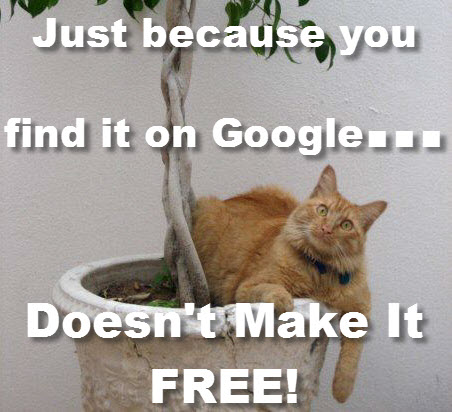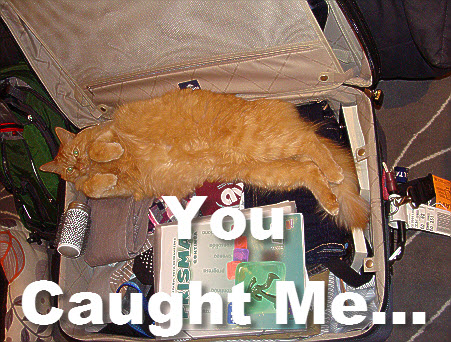Lately, we’ve been hearing more and more about digital copyrights and fair use in the news and online – particularly with the whole SOPA/PIPA uproar that recently swept the web.
Also, we on the Edublogs support team have been getting more and more complaints and official requests to remove copyrighted content that users have placed on blogs.
The legal jargon with respect to digital copyrights can be confusing – especially since different countries have their own laws and regulations.
With this post, we hope to dispel a few myths and pull together a complete list of resources for teachers and students to use when blogging and working with content online.
Rule #1: You Can’t Use Everything You Find On the Web

This may seem obvious, but judging by the notices we have received, many teachers (and especially students) are under the impression that if it is on the web, then it is up for grabs.
If you and your students keep rule #1 in mind, then everything else should be fine.
Rule #2: There Are Resources You CAN Use
One of the myths out there is that you can’t use any image, video, or content from another website on your blog.
That simply isn’t true, and we’ll cover our favorite sources of “fair use” and “public domain” sources at the end of this post.
It is troubling that while copyright is important to protect the hard work of others, it can also stifle creativity and hamper educational goals. Though SOPA is effectively dead at the moment, there is a legitimate need for newer laws that are built around the open and free-sharing nature of the web.
Understanding Fair Use
You might be aware that as educators, we have a few more flexible rules, called “Fair Use”, to play by.
That is, in some cases, if an image, text, video, etc. is being used for educational purposes, there might be more flexible copyright rules.
For example, a video that was purchased in a store can usually be shown in a classroom when the video is tied to the curriculum being taught. Otherwise, showing a class full of students a video would be considered a “public performance” and would be against the law.
The trouble is, most of the laws and rules that cover fair use and education were written well before the invention of the web.
While a textbook or curricula resource might allow for photocopying for classroom use, it most likely isn’t going to allow you to make a PDF of the document and put it on your class blog or website for students to print themselves.
The end result would be the same, right? A student would have a printed copy.
But make sure to check specific copyright restrictions before uploading anything you’ve scanned to the web!
For more, check out the Fair Use FAQ for Educators here from the excellent resource site, TeachingCopyright.org.
What Can Be a Violation?
Here are the most common types of content that we have been contacted about and asked to remove on our blogs:
- Images – mostly found through google image search
- Curriculum docs – especially handouts and student activities
- Text and quotes – copy/pasted from other websites (even with a link or attribution it still may not be legal)
- Music – usually mp3s that students have uploaded to share on their blogs
But I Won’t Be Caught…
If only that were true.
Google makes it incredibly easy for companies and content creators to seek out those posting their work on the web.
Sadly, we are also noticing more and more “law firms” and organizations out there looking for copyrighted content as a way of generating business. They then contact the copyright holder offering their services to get the content removed (for a fee of course).
It is a ruthless (and apparently profitable) practice, and we’d be lying if we haven’t argued with a few that contact Edublogs about how they are hurting the education of students. But let’s keep on topic…
What If I Am Caught?

Well of course in this case a good offense is your best defense. Check your blogs and class websites for any potentially offending material. If you find anything, just remove it.
The law requires copyright holders to give you (and the host of your site, such as Edublogs, WordPress, etc.) an official notification. Take these seriously and act quickly to remove what they want if you are in the wrong. That should be the end of it.
We were recently notified about a teacher with a blog on Edublogs that had a harmless world map image on his blog that he had presumably found using Google image search. When we contacted him telling him why we had removed the image, he asked if he and his students could write an apology letter to the copyright holder.
It was excellent – turning what could be a bit of an embarrassing mistake into a teachable moment for his students! Now this teacher had a good reason to discuss copyright and creative commons with his students…
So What Is Creative Commons?
One thing to look for when figuring out if a resource (ie. image, video, text, etc.) is free to copy or embed on your blog, is a Creative Commons license.
For example, look at the bottom right corner of the sidebar of this blog. You’ll see that we license all content on this blog as “Attribution – Non-Commercial – Share Alike”.
That is fancy talk for letting you know that you are free to use anything on this blog as long as you:
- give an attribution or credit that lets others know where you got the info with a link,
- won’t profit in any way from using our content and use it for non-business purposes only, and
- anything you create with our content, you must use the same license.
Luckily, the CreativeCommons.org website has a ton of excellent information and makes it easy to grab the license you wish to have on your own blog. If you (or your students) have blogs, then it is a good idea to choose the most appropriate license and make it visible on your blog.
In our case, we pasted the code they provided into a blank text widget in our sidebar.
Where To Find The Goods

Images
Creative Commons Search – Search many sites at once *Our Favorite!
StockVault.net – Free images from photographers around the world
Kozzi.com – One free photo per day
FindIcons.com – Huge resource for avatars or small images
Flickr Advanced Search – Use advanced search filters to show only CC licensed images
Morguefile – Free stock photos (Thanks Sue Lyon-Jones for link in comments!)
Open Clipart Libary – Public domain clipart (Thanks Sue Lyon-Jones for link in comments!)
Videos
You are free to embed any video from YouTube, Vimeo, WatchKnowLearn, etc. on your blog or website as long as it gives you the embed option.
That being said, you (or your students) can’t necessarily use parts from videos on YouTube (or other sources) to make mashups or as part of another video. Be sure to have permission to use any video that you are cutting, making changes to, or adding to a project.
Curriculum and Text
Wikipedia – Quote away (with a link back) to any information you find on Wikipedia
Curriki – An open curriculum community
Collaborize Classroom Library – A growing resource for discussion questions, lesson plans, and more
You won’t be able to add student resources from most textbook companies or purchased curriculum – so be careful and make sure you have permission before doing so!
Related Posts and More Info on Copyright
How To Attribute Copyrighted Works
Larry Ferlazzo’s Best Lists: Learning about copyright, best places for images, and best places for audio
Answering Reader Questions
(Edit: 2/22/2012 – This section was added to include responses to comments and tweets we’ve received since publishing the post)
In private or for-profit institutions, how can we use images and video, if at all? Is it even okay to use YouTube videos in class? What about online articles? Is there a difference between a class of paying students and a training delivered to teachers?
First, any images, videos, or content under a Creative Commons license will let you freely use the material with your student, you just may not be able to turn around and sell any changes you make. Any video on YouTube should be fine for showing in class, and if an image is on the web, you can always display the website that contains the image – where the line is drawn is on copying that image and pasting it on your own blog or website.
Can the onus not be placed on those who post these potential classroom materials, to make it clear who can and can´t or used for and not used for, surely this would be the least time consuming option.
Excellent point! Awareness of copyright and the importance of website owners to make it clear their licenses is improving. I think sticking to trusted sources and using filtered searches is the safest option.
If you can’t use images from the internet why is it that google can group all the images together for people to use?
Interesting thought for sure. Website owners can ask Google not to index their sites and images with a quick code. For bloggers, under Settings > Privacy, users can do the same thing. Not sure that really answers your question though 🙁
Is there a straightforward way to get the permission needed to use a ‘clip’ from a you tube video?
I’ve seen people leave a comment on the YouTube post, but there is no guarantee you’ll get a response.
Some YouTube videos are licensed under a Creative Commons license, and there is an advanced search filter on YouTube that would let you search for these. If you find one, you could use it without permission as long as you follow what the license allows (ie. provide attribution and not make money on the project).
What about the LIBRARY!?
Not so much a question, but Elijah left an excellent comment down below remind us that this is exactly why our libraries can be such valuable resources. Libraries have access to tons of licensed materials and librarians are specially trained to help us navigate the difficult copyright laws. Thanks, Elijah, for the tip!
When I get permission to post something that’s been copyrighted, am I supposed to share it a certain way so others that I have permission to use?
The answer here really depends on the license of the original content and the agreement you have with the original owner. Most of the time a link back to the original works perfect. The location of the link could be in an image caption, in the text itself, or at the end of your piece (like the “References” section of a formal paper).
Maybe APA/MLA/etc. should come out with a set of web publishing guidelines that include citations and reference lists! How would something like that even get started?
Can students read published books aloud, record themselves & publish recording on class blog?
The answer to this is probably not 🙁
However, many books are in the public domain – including most books written before the 1930s. These are all of the free books you see in the e-reader stores. Students would be free to record themselves and publish any book in the public domain. It should say somewhere near the beginning of the book if it is in the public domain (where copyright and publisher information usually goes).
What Do You Think?
Have we missed any important tips or good sites to find resources that are free to use?
Let us know in the comments below and we will be sure to add it to the post!

If a student is using a “google image” in a powerpoint or for a class project (not a blog or video or anything that will be made public on the internet), does that fall under Fair Use?
Question. If I saw a image on a facebook page of the state of sc with the words andrews strong added in. Can I copy that image and use it? Reason asking I like to sew. Can I sew it on a shirt pocket? for myself and friends? not as profit, as gifts. The guy that I copied the image from is saying he will sue me. But it allowed me to copy and it does not state that it has a copy right. Please help. Thank you. Am I breaking the law????
Who should I contact regarding the possible purchase of a you tube video, the original developer or Google, or who else?
I take photos from the Internet and combine them with text. I have written down the copywrite for the original pictures on my post but I’m not sure if I should write it differently.
I saw a worksheet on the properties of addition that someone else made. I would like to make one for the properties of multiplication using the exact same format – like modeling it after that worksheet exactly, similar directions and same look, just changing content. Is that okay?
a student decides to use a copyrighted video clip in a multimedia presentation for school and posts it to the internet for all to see. is it legal or illegal? because i really need to know
a student decides to use a copyrighted video clip in a multimedia presentation for school and posts it to the internet for all to see. is it legal or illegal?
I bout a all inclusive curriculm book for my Kindergartener. It includes a full school year of lesson plans, teaching suggestions and reproducible activity sheets. I would like to share it on my tiny blog (mostly among friends). I tried in vain to see if this was allowed. Could you give advice on this? Thanks!
How about if a student makes a video on a specific topic and there’s a recognizable image in the backgound (a painting or map). The video is put up on YouTube for veiwing by the class. Woudl there be need to get permission for the background image, even if it is not the focus of the lesson in the video?
Most of these questions and discrepencies are towards commercial or educational. I need a strict yes or no towards copying print for personal use within a home decor.. Majority of us in the decorating world see that what is available does not stand up to what we’re aiming for in decor. It is so easy to find images that we love to decorate our home with. From one issue to the next, this bothers me.. I am not selling anything on etsy, I am not using it for a school project or educational.. I simply want to use it as wall decor, nothing more..
If I edit the image for size, for brightness or to meet a color scheme.. if I add lyrics to the image to give an intended idea of the art.. Again, none of this is for profit. If these images were readily available, I would happily purchase them but they are not and we seek out different ways of expressing our creativity within a home. I am told certain websites are public domain images, therefore it is always fair use.
In my case, images I have wanted to print are usually a still, screenshot from something I watched via netflix, etc., I then edit to fit a color scheme and sometimes include an italisized lyric.. Another comes from alot of abstract artwork for purchase.. however, they are small prints.. I want to expand the artwork into perhaps tapestry or canvas size.. Going to a print shop, I understand the copyright laws and what not but at the end of the day, my use is fair because I am not trying to gain profit. I simply am looking for home decor that suits me that I have not been able to find for purchase. Majority of artwork for home decor is a dime a dozen, similar patterns or small prints for the price of large prints and not suited for some color schemes.
What can I do at a print shop to be clear that this is not for profit or commercial use and simply to express creative freedom within the privacy of my own home? Tell me what I can do that is legal and respectful of the artist and that demonstrates I am not in the intention of using this for entreprenueral reasons. Most of the images I have wanted have not made a dent in sales or come from sources that you will hardly ever see artwork for because the material is dated or not popular enough to have decor items readily available for consumer. What can I do to demonstrate that I respect the artist and simply want to use it for personal expression within a home..
I want to create a bulletin board to encourage my students to read. Is it ok for me to copy and use book covers from popular novels to put on the board?
Is it OK to use some of this info. for an inservice for elementary school teachers? I am a elementary school librarian.
What if I get the picture off Amazon.com? Is that allowed in pictures and videos?
Kozzi.com – One free photo per day –> When I was checking out the sites for Images, the one free photo per day no longer seems available. It is now a 30-day free trial, and $4.95 monthly after that. Might have changed since this was originally posted in 2012.